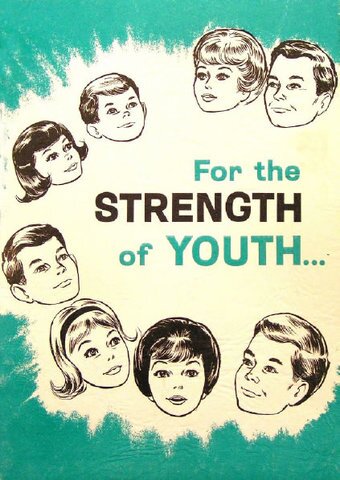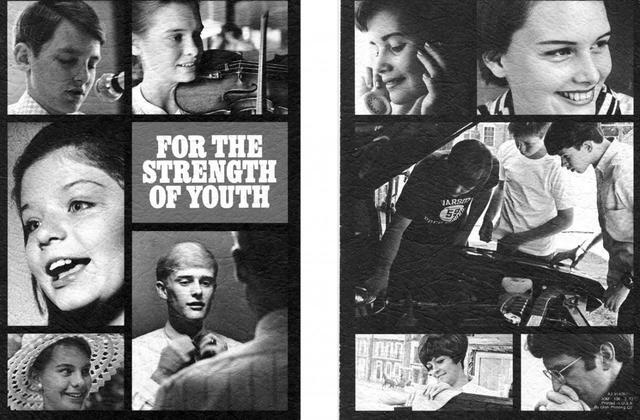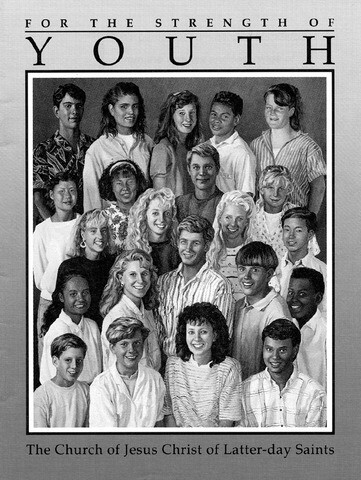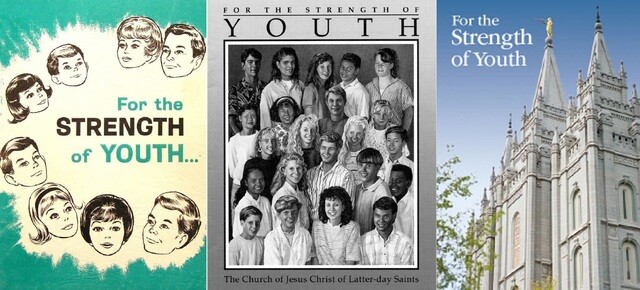Editor’s note: This article was originally published in 2016 and updated in October 2022.
Whenever I’ve heard my mom or other women from earlier generations claim they couldn’t wear pants to school, I’ve treated their words as myths—kind of like the classic dad story about walking two miles to school in the snow and uphill both ways. But when I traipsed over to the Church History Library and looked through the For the Strength of Youth pamphlets from the past, I found hard evidence that it was, in fact, considered inappropriate for young women to wear pants to school and several other places.
Deep down, I always knew it was true, but I was still surprised when I saw that the first edition of the pamphlet, published in 1965, advised young women not to wear pants “for shopping, at school, in the library, in cafeterias or restaurants.”
Can you imagine this kind of guidance for young women today? It was no doubt the right guidance for the youth to whom it spoke, but as things have changed, so has the pamphlet. Seeing these changes to the For the Strength of Youth pamphlet has opened my eyes to the Church's awareness of the needs of youth at all times, whether it be the 60s and 70s or the late 90s and early 2000s. Here are some of the highlights from the different editions:
1965–72

Image of the 1965 For the Strength of Youth from byu.edu.
Between 1965 and 1972, seven editions of the pamphlet were published, including the very first edition. A lot of the guidance in these early editions of FSOY was geared towards propriety and acceptable behaviors. Under the section “Good Grooming,” it reads, “Not only should clothes be clean, but nails, skin, and hair should have the glow of health that bespeaks meticulous care in grooming.” Youth were also reminded that “it is not polite to run in and out of motel or hotel rooms late at night, making a disturbance which keeps other guests awake.”

Image of the 1972 For the Strength of Youth from byu.edu.
Some of the directions in these earlier pamphlets are more detailed than the FSOY pamphlets we know today. For example, in the section titled “‘Grubbies,’ Curlers, Hair Fashions,” girls were counseled not to leave the house in their “grubbies.” The next sentence states: “A ‘real lady’ does not go out in public, to the market, or to shops with her hair curlers.” (Most of today’s young women probably don’t even know how to use hair curlers.)
Young women were not only to avoid backless and strapless dresses because of immodesty, but also because, according to these early pamphlets, “few girls or women ever look well in backless or strapless dresses. Such styles often make the figure look ungainly and large, or they show the bony structures of the body.”
1990 Edition

Image of the 1990 For the Strength of Youth from byu.edu.
Society must have changed drastically in the years to follow because For the Strength of Youth was almost completely different when it was updated in 1990. The Church standards remained the same, but the world seemed to be in more need of moral direction. “The title For the Strength of Youth is not new,” explained Ardeth Kapp, the Young Women general president at the time. “But because of the trend toward immorality and other ills in society and also because of the expansion of the Church into new geographical areas over the years, a more comprehensive, more explicit statement of Church standards was needed.”
The 1990 edition of For the Strength of Youth contained several more sections of what Sister Kapp said was needed—explicit statements of the Church’s standards. Youth were still taught about appropriate dress and dating, as in earlier editions, but topics like language, sexual purity, mental and physical health, and Sunday behavior were added.
There were still some specific directions on subjects such as dress. While pants and “grubbies” no longer raised concern, short shorts, tight pants, and other revealing attire, including off-the-shoulder and low cut shirts, became an issue. Youth were counseled to “dress in such a way as to bring out the best in yourself and those around you.”
2001 Edition
Image of the 2001 For the Strength of Youth from byu.edu.
In 2001, FSOY expanded from just 19 pages to 44. This pamphlet was geared even more toward spiritual principles, with sections such as “Agency and Accountability,” “Gratitude” and “Go Forward with Faith.” “The Living Christ” and “The Family: A Proclamation to the World” were also added to the back of the pamphlet, and instead of a picture of youth on the front, the cover displayed a picture of the temple. The introduction to the “Dress and Appearance” section illustrates this more spiritual update: “Your body is God’s sacred creation. Respect it as a gift from God, and do not defile it in any way. Through your dress and appearance, you can show the Lord that you know how precious your body is.” Youth were not only supposed to dress appropriately because it was socially acceptable but because of their spiritual beliefs about the body.
2011 Update
Image of the 2011 For the Strength of Youth from Wikimedia Commons.
In December 2011, the Church announced it would release a new and updated version of the pamphlet. For me, though, it didn’t seem like we were really that far removed from 2001. Had things really changed that much? The 2001 edition seemed to be sufficient for today’s youth—until I looked through the 2011 edition. It’s interesting to note how much things actually have changed. A lot of material in the updated version of FSOY is the same as before, but some additions are clearly vital for our time. In the “Music and Dancing” section, for instance, youth receive this counsel: “Keep your music at a reasonable volume, and remove your earphones when others are talking to you or want you to be part of their activities.”
Another interesting and certainly important addition comes from the section “Sexual Purity.” It counsels youth to “avoid situations that invite increased temptation, such as late-night or overnight activities away from home or activities where there is a lack of adult supervision.” Nearly every section has been expanded by a paragraph or more, and there's even a whole new section--"Work and Self-Reliance." Would the Church have made these additions to the pamphlet if they weren’t important for our time?
2022 version
In October 2022 general conference, Elder Dieter F. Uchtdorf announced the release of a new version of the booklet, available in 50 languages. A new subtitle, A Guide for Making Choices, was added.

Same Principles, Different Words
Even though FSOY has changed, the principles have remained consistent. “The standards have not changed, but times have changed,” said Elaine S. Dalton, former Young Women general president. “For the Strength of Youth has been revised to address the issues youth face today—to teach them the doctrine behind the standards and the promised blessings of obedience.”

